Events and excursions, Summer 2014
Tutbury Castle and Church, and Hoar Cross Church, 22 May 2014.
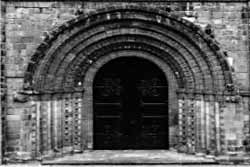
The West Door of the Priory Church of Saint Mary the Virgin, Tutbury
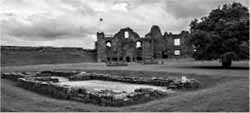 Tutbury Castle: the South Wing and excavated Chapel
Tutbury Castle: the South Wing and excavated Chapel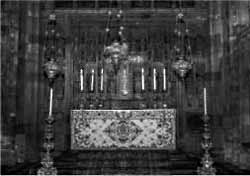
The Altar at the Church of the Holy Angels, Hoar Cross
Photos by Howard Fisher
Report by Leader, Alan Langton.
The journey to Tutbury through Derby gave members some good views of a city which many of us had not seen for a while, leading to a suggestion that at a future date an excursion here could be quite popular.
Tutbury Parish Church
On arriving at Tutbury we went directly to the Priory Church of Saint Mary the Virgin to be met by Mr. Paul Nicholas who, despite protestations that he felt inadequate addressing historical societies, gave us a wealth of information about the church.
As we walked up the pathway to the church we faced the great west end with the splendid Norman carved doorway, dating back to its foundation as a Benedictine Priory about 1089 by Henry de Ferrers in memory of the recently deceased William the Conqueror and his wife Matilda. What survives of the original building are the western six bays of an original eight bay nave, with pillars reminiscent of those in Southwell Minster. This became the parish church after the Reformation, when the rest of the great monastic buildings were destroyed. Above the walls there used to be a triforium gallery with a clerestory. In the 1860s G. E. Street restored the building, and built a new barrel roof of ingenious craftsmanship. The restored chancel was the gift of Sir Oswald Mosley in 1868. Other interesting features are mostly Victorian or early 20th century and include the 39 Glastonbury Chairs all bought as memorials, the peal of eight bells, the stained glass and the reredos. A modern project only installed four years ago is the enclosure of the north aisle by a fine and tasteful wooden screen and sub-roof to provide a comfortable and warm meeting room, toilets and a kitchen.
Tutbury Castle - lunch and entertainment
Members walked to the nearby ruined castle of Tutbury with its splendid commanding view over the surrounding countryside for many miles. In the Great Hall we enjoyed an excellent lunch.
The Hall was then transformed into the throne room of Mary Queen of Scots who was imprisoned here on four occasions, until she was sent to Fotheringhay where she was executed in 1586.
The Castle Curator and English Reformationist Historian, Lesley Smith, in full authentic costume, then entertained us for about an hour with a dramatic and outstanding presentation of the ‘persecuted’ queen’s critical outbursts about her prison, her treatment by Elizabeth l, her laments about her three marriages, and her resented rejection as the ‘rightful’ queen of England.
Hoar Cross
From Tutbury we travelled to Hoar Cross to see the amazing 19th century Bodley church, built in 1872 by Emily Ingram, the daughter of Viscount Halifax, in memory of her husband, Hugo, to whom she had only been married for seven years.
Our guide here was the 96 year-old verger, Derrick Cross.
The extravagant and enormous Church of the Holy Angels was built in Anglo-Catholic design, with no expense spared in the decoration and fttings. The tomb for Hugo was to be the most elaborate feature, but equally the stone reredos, the fourteen specially commissioned carved Stations of the Cross, and the font are blatently extravagant.
Since the church’s original construction, further additions amazingly have been made, including two side chapels, a black and white marble foor, a narthax, a lengthening of the nave, and the installation of an organ from Bangor Cathedral. In view of the church’s isolation from surrounding villages, members were left wondering how the upkeep of such a building is possible today.
A most entertaining and memorable day.
Southwell - Burgage Manor, Sunday 8 June 2014
Report by Leader, Alan Langton.
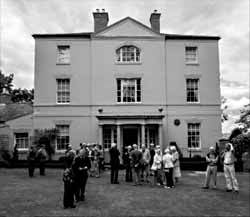
Members assembling in front of the house
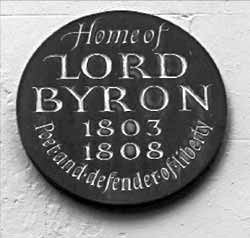
Plaque on front of the house
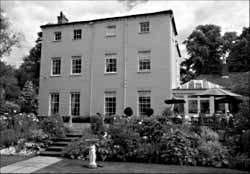
The rear of the house from the garden (Photos: Howard Fisher)
Arriving in the town of Southwell on the afternoon of 8th June could easily have led to the conclusion that the strains of music indicated that the Thoroton Society was about to participate in a festive music fair of Morris Dancers and other instrumental groups. The men with bells around their legs, however, soon went their way along Southwell streets other than the Burgage.
Thirty members of the Society were met and warmly greeted by Mr. Geoffrey Bond, a member himself, and his wife Dianora, the proud owners of Burgage Manor, where the young Lord Byron and his mother once lived between 1803 and 1808.
The group divided into two sets, one under the direction of Geoffrey Bond to be taken around the house, and the other under the direction of the gardener, Jonathan Wild, to be taken around the gardens. The memory and knowledge of both guides was awe-inspiring for members.
I am not sure what members had expected, but both in the house and the gardens our eyes were opened and our amazement was stunned when we viewed the collection of papers, books, prints and documents which Geoffrey has collected over the years, and the beauty and variety of the fowers, trees and shrubs which Jonathan has nurtured over the last few years. The antiquity and unique value of some of the objects, especially those connectd with Byron, and the immediate profusion of arrangement and colour in the gardens took many member’s breath away.
The afternoon was enhanced even further by two additions: first, we had a beautiful sunny afternoon with no hint of rain or cloud, and secondly, we were entertained to an appropriate afternoon tea in the gardens by Dianora and her helpers.
This was without doubt a memorable Thoroton Society event.
Mr. Bond asked for no contribution from members for the visit, but as a thank-you for his generosity we were able to contribute to his support for the Southwell Care Fund.
Egmanton, Edwinstowe and Rufford Park - Thursday, 26 June 2014
Report by Leader, Alan Langton.
After a delighful run through north Nottinghamshire countryside our first stop was Egmanton church, a site of medieval pilgrimages, either in its own right or becaue it was a stopping place on the route to Walsingham.
We were met by Jean Wright, who gave us much information about the church building and its noteworthy aspects. Work is currently being completed to repaint and gild the woodwork on the organ screen and doors by a specialist; who has already completed the beautiful rood screen. These screens date from a complete restoration of the church by Ninian Comper in the 1890s at the request of the Duke of Newcastle. As a bonus we were able to see Michelle at work.
The building boasts a Norman doorway and font, some 14th century glass, and tombs of the early benefactors of the church, including Nicholas Powtrell, who occupied Egmanton Hall during the reign of Elizabeth 1.
From Egmanton we travelled to Edwinstowe, and enjoyed a knowledgeable talk, jovially given by Margaret Woodhead, who is a Reader there.
The origins of the building may go back to the evangelisation of the area by Paulinus in 627 AD in the time of King Edwin.
The stone building dates fom 1175, and it is possible to see the outline of the original roof on the west wall before the building was enlarged: the stone pillars and arches on either side of the main aisle show a similar development. The south aisle was added as a chantry chapel by Henry and Robert Edenstow in the 1340s. At the back of the north aisle there is a modern community map of the parish delicately worked in embroidery. The broach spire of the church was added to the Norman tower in 1400, although it had to be rebuilt in 1680 after a storm.
From Edwinstowe we moved on to Rufford, for an enjoyable lunch in the Savile restaurant.
After lunch we had a talk by Sarah Law who gave a lecture to the Society two years ago, and who is currently doing considerable research into the original lay-out of the grounds of the Park, first created by the Savile family in the early eighteenth century when wealthy landowners competed with each other to see who could create the most elaborate garden. After her talk, Sarah took the group on a tour of the grounds to point out aspects of the original terrain, which clearly were the remains of considerable earth moving and water features: the casual observer would not be able to imagine much of what has subsequently happened to the grounds since the 1730s, but Sarah’s knowledge and her powerful enthusiasm and exciting presentation were able to bring to life for members a clearer understanding of Rufford Park as it once was.
Digital Showcase for Local History
A meeting report by Judith Mills
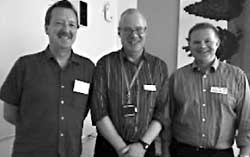
The three speakers from left to right: John Parker, Tim Warner, Nick Tomlinson. Photo: Judith Mills.
On 16 July 2014 representatives from several Nottinghamshire local history societies attended a meeting at West Bridgford Library to hear more about the digital resources that are provided or sponsored by the Nottinghamshire County Council Libraries and Archive Service. The event began with demonstrations of the websites supported by the Library Service. Tim Warner (Local Studies Librarian) began by showing the Our Nottinghamshire community history website (http://www.ournottinghamshire.org.uk/index.aspx). As a community website, the information on this site has all been researched and written by members of history and community groups from across the county. Anyone is free to send in a contribution. There is also the opportunity to comment on the articles and provide new information. If you have not seen it before, it’s well worth a look.
Nick Tomlinson then demonstrated Picture the Past (http://www.picturethepast. org.uk) which many Thoroton members are probably very familiar with. It holds in excess of 100,000 pictures of Nottinghamshire places and people and is growing all the time. There is also the opportunity to buy copies of the pictures and a whole range of items, from fridge magnets to greetings cards, decorated with your favourite picture. Although apparently trivial, such sales help to pay for the maintenance of the site; though the main income comes from providing images to organisations such as TV companies and major publications. Nick is keen to add more pictures to the collection and is happy to visit groups to talk about the site; he will even take along a portable scanner to take copies of old pictures if anyone wanted to take some along. There’s more information on the web site and Nick can be contacted by email at admin@picturethepast.org.uk.
Finally, Peter Lester from Nottinghamshire Archives talked about the Nottinghamshire Archives World Wide Catalogue. (http://nawcat.nottinghamshire.gov.uk/DServe/DServe. exe?dsqServer+AP266-0029&dsqApp= Archive&dsqCmd=Index.tcl). From this list it is possible to find many of the documents held by the Archive, though it has not been possible to convert the entire catalogue yet and the project is on-going. All new acquisitions are immediately entered into the digital catalogue. This on-line resource makes searching the catalogue much quicker, and also makes it available to people who are not able to visit the Archive simply to search the paper record.
All these sites are freely available from the comfort of your own home, and free of charge. All three are frequently accessed by people from around the world and therefore are spreading the word about the County and its history.
The demonstrations then moved on to websites for which the County has paid subscriptions which can be used when visiting Libraries, but unfortunately not from home, even if you do own a library card.
First we looked at Ancestry which is a website with which many Thoroton members are probably familiar. When used in connection with FreeBMD (http://www.freebmd.org.uk), which is a free website that you can use from home, it is possible to trace much genealogical detail.
A second subscription is the British Newspaper Archive. This comprises newspapers from the 18th to the 20th centuries, though they are mainly the larger town and city journals, not local publications. Anyone who has tried doing newspaper searches from microfiche will appreciate how much time (and eye strain) can be saved by doing an on-line search. The County subscription to this service replaced its subscription to 19th Century Newspapers online in May. Both services have similar - but not exactly the same - collections of newspapers, but the new service has the advantage of not being limited to just the 19th century and is therefore more extensive.
One of the purposes of this first Showcase meeting was to consider ways in which local history groups, library services and archives can work together to promote Nottingham’s history, not just across the county but also to a much wider audience. It was decided that the first task was to create a full list of all local history and interest group websites, and sites such as Picture the Past and Our Nottinghamshire, where information is available; Nottinghamshire Local History Association has agreed to begin this work. The group will meet again in a few months time to consider what should be done next. If you have any thoughts, suggestions or comments about using the digital resources then please do get in touch with me so that I can pass them on mail@judithmills.eu.
[Ed: the BALH has already compiled a list of such web sites so, hopefully, the NHLA will liaise with them rather than repeat the same work].
First Nottinghamshire Archaeology Day
Report by John Wilson
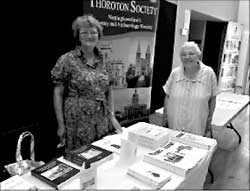
Penny Messenger and Margaret Trueman manning the stand at the Archaeology Day.
On 21 June 2014 the Thoroton Society was one of over thirty local history and archaeological societies who took part in the county’s first county-wide Archaeology Day, which was held at the University of Nottingham. The day was organised by the Curator of the University Museum, Dr. Clare Pickersgill. Participants also included museums, regional archaeological units and heritage groups, all of whom showed examples of their current work. There were two large galleries full of archaeological material where people attending could see, and in many cases handle, everything from Palaeolithic hand axes to Saxon pottery. Some members of the public took the opportunity to have artefacts identifed.
The Historic Environment record and the Portable Antiquities Database were demonstrated so that vistors could find out about archaeological work being carried out in the county. The Thoroton Society stall received many visitors, a number of whom showed serious interest in our work.
Hopefully we may see some of them at future meetings.